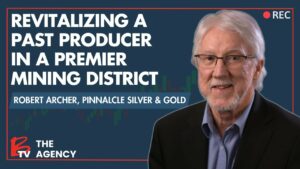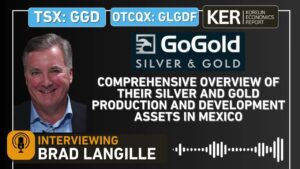All dollar amounts are expressed in US$
Equinox Gold Corp. (TSX: EQX, NYSE American: EQX) (“Equinox Gold” or the “Company”) is pleased to announce a positive preliminary economic assessment (“PEA”) for development of an underground mine at the Company’s 100% owned Aurizona Gold Mine (“Aurizona”) in Brazil. The underground mine could be operated concurrently with the existing open-pit mine and has the potential to deliver an additional 740,500 ounces (“oz”) of gold, $1 billion in revenue and $204 million in after-tax net cash flow over a ten-year mine life at a base case gold price of $1,350 per oz.
PEA Highlights for the Piaba Underground Mine (at $1,350/oz gold)
- 740,500 oz gold production from the underground mine, in addition to existing open-pit gold production
- 2,800 tonnes per day (“t/d”) mill feed at steady state from the underground mine
- PEA mine plan incorporates 2.8 million tonnes of Indicated Resources grading 2.73 grams per tonne (“g/t”) gold and 6.2 million tonnes of Inferred Resources grading 2.89 g/t gold
- Mined using low-cost long-hole open stoping method
- Processed using the existing 8,000 t/d plant and other existing surface infrastructure
- Initial capital costs of $69.7 million and sustaining capital of $138.4 million1
- $1 billion gross revenue with a post-tax net cashflow of $204 million
- All-in sustaining costs of $925/oz1
- $122 million after-tax net present value discounted at 5% (“NPV5%”) ($228 million at $1,620/oz gold)
- 25% internal rate of return (“IRR”) (38% at $1,620/oz gold)
1 Sustaining capital and all-in sustaining costs are non-IFRS measures. See Cautionary Notes.
Christian Milau, CEO of Equinox Gold, stated: “This PEA demonstrates the substantial opportunity for both mine life extension and increased annual gold production at Aurizona through development of an underground mine. With the potential for expansions to the current open-pit, additions of other near-surface resources and further opportunities for Piaba underground resource expansion at depth and along strike, Aurizona is expected to be a long-life cornerstone asset for Equinox Gold.”
The PEA is included in Section 24 of the “Technical Report on the Aurizona Gold Mine, Brazil” (the “Technical Report”) dated April 27, 2020. The Technical Report was prepared by AGP Mining Consultants Inc. (“AGP”) with contributions by Equity Exploration Consultants (“Equity”) and will be filed within 45 days on SEDAR at www.sedar.com, on EDGAR at www.sec.gov/EDGAR and on the Company’s website at www.equinoxgold.com. The PEA is preliminary in nature and includes Inferred Mineral Resources that are considered too speculative geologically to have the economic considerations applied to them that would enable them to be categorized as mineral reserves. There is no certainty that the results contemplated in the PEA will be realized.
Overview
The Piaba mineral deposit contains high-grade gold mineralization in a multiple vein system that extends at least 4 kilometres along the Aurizona Shear Zone. The mineralization extends below the open-pit that is currently in production at Aurizona, has been drill tested to a depth of approximately 600 metres from surface and remains open at depth and along strike. The current underground portion of the resource estimate includes an Indicated Resource of 7.3 million tonnes grading 1.96 g/t gold and an Inferred Resource of 16.5 million tonnes grading 1.98 g/t gold. Only the portion of the Indicated and Inferred Mineral Resource that is within the PEA mine design and above a cut-off grade of 1.50 g/t to 1.85 g/t (depending on depth) is included in the base case PEA underground mine plan.
The underground deposit could be mined and processed concurrently with mill feed from the open-pit at Aurizona resulting in a higher average mill feed grade. Underground mine production would be processed through the existing 8,000 t/d plant and use other existing surface infrastructure. Base case PEA economics for the underground mine were determined using a gold price of $1,350/oz and include a 1.5% royalty payable to the Brazilian government and a 3% royalty payable to Sandstorm Gold Royalties2.
2 Sandstorm royalty rate increases to 4% at gold prices from $1,500 to $2,000/oz and 5% at gold prices over $2,000/oz.
Table 1: Summary of Results of Base Case PEA for the Piaba Underground Mine
| Description | Unit | Value |
| Gold Price (base case) | $/oz | $1,350 |
| Underground Production | ||
| Tonnes1 | kt | 9,014 |
| Grade1 | g/t gold | 2.84 |
| Contained Gold | koz | 823.6 |
| Recovery | % | 90% |
| Gold Sold | koz | 740.5 |
| Net Revenue | $M | $999.6 |
| Capital Costs | ||
| Initial Project Capital | $M | $69.7 |
| Sustaining Capital2 | $M | $138.4 |
| Financial Results | ||
| All-In Sustaining Costs2 | $/oz | $925 |
| Life of Mine Net Cashflow | $M | $204.2 |
| After-tax Net Present Value (5%) | $M | $122.2 |
| After-tax Internal Rate of Return | % | 24.9 |
| Payback Period | Years | 3.3 |
1. The base case PEA underground mine plan extracts 2.8 million tonnes of Indicated Resources grading 2.73 g/t gold and 6.2 million tonnes of Inferred Resources grading 2.89 g/t gold over an operating period of approximately ten years. 2. Sustaining capital and all-in sustaining costs are non-IFRS measures. See Cautionary Notes.
Mining
The PEA contemplates development of an underground mine along a total strike length of 3.3 kilometres to access an initial eight separate mining areas. The internal ramps will be accessed from surface by a common main double ramp arrangement developed directly into fresh rock from within the existing open-pit. All mine development is in more stable rock units located on the hangingwall side of the mineralized body (Figure 1).
Figure 1: PEA Underground Development Design (isometric view to southwest) Below Piaba Open-Pit

The proposed mining method is long-hole stoping due to the good ground conditions and steep dip of the deposit. The PEA contemplates owner mining of stopes and underground development. Completed stopes would be filled by rockfill from underground development or open-pit waste. The addition of cement to rockfill is confined to the higher-grade areas where mining recovery can be maximized by eliminating the need for rib pillars and above sill pillars.
First mill feed from the underground mine would be expected approximately 2.25 years after the start of underground mine development, with steady-state production of 2,800 t/d being achieved at the end of year four and continuing through year 11 within the currently defined mineral resource (Figure 2). The mine plan schedules higher-grade areas earlier in the underground mine life to enhance mine economics (Figure 3).
Figure 2: PEA Production Schedule for Piaba Underground Mine

Figure 3: PEA Recovered Gold for Piaba Underground Mine

Capital & Operating Costs
The underground mine will use and benefit from the existing process plant and other infrastructure currently used by the operating open-pit mine including power, water and tailings storage facilities. No additional processing or other surface infrastructure is contemplated in the PEA and capital estimates are confined to underground mine development and sustaining costs. Initial capital costs are estimated at $69.7 million and sustaining capital is estimated at $138.4 million over the duration of the PEA mine plan (Table 2). Total initial and sustaining capital cost estimates include a 25% contingency and recoverable and non-recoverable taxes.
Table 2: Summary of Base Case PEA Underground Mine Capital Estimates
| Description | Initial Capital ($M) | Sustaining Capital ($M) |
| Underground Mine Development | 27.7 | 70.3 |
| Initial Purchase of Mobile Equipment | 17.9 | 21.6 |
| Mobile Equipment Replacement | – | 6.0 |
| Mine Infrastructure | 5.8 | 5.2 |
| Contingency (25%) | 12.9 | 25.8 |
| Non-recoverable Taxes | 3.5 | 6.2 |
| Recoverable Taxes | 1.8 | 3.4 |
| Total1 | 69.7 | 138.4 |
1. Numbers may not sum due to rounding.
Base case PEA operating costs and site all-in sustaining costs for the underground mine are provided in Table 3.
Table 3: Summary of Base Case PEA Operating Costs and AISC1
| Description | $/tonne | $/oz |
| Underground Mining Processing G&A Non-recoverable Taxes (Operating) Refining and Transport | 33.82 12.13 4.89 | 412 148 60 45 20 |
| Sub-total Cash Costs | 683 | |
| Royalties | 60 | |
| Total Cash Costs | 743 | |
| Sustaining Capital Costs1 | 174 | |
| Non-recoverable Taxes (Capital) | 8 | |
| All-In Sustaining Costs1 | 925 |
1. Sustaining capital and all-in sustaining costs are non-IFRS measures. See Cautionary Notes.
Economic Sensitivities
Using the base case gold price of $1,350/oz the underground mine has an after-tax NPV5% of $122 million and an after-tax IRR of 25%. At $1,620/oz gold, the after-tax NPV5% increases to $228 million with an after-tax IRR of 38%. The project’s NPV5% is most sensitive to fluctuations in the gold price, as summarized in the table below.
Table 4: Base Case PEA After-tax NPV5% Sensitivity to Gold Price and Cost Inputs ($M)1
| Input | -20% | -10% | Base Case | +10% | +20% |
| Gold Price | $3 | $63 | $122 | $179 | $228 |
| Operating Costs | $180 | $151 | $122 | $92 | $61 |
| Capital Costs1 | $152 | $137 | $122 | $107 | $92 |
1 Includes initial capital and sustaining capital costs. See Cautionary Notes.
The PEA includes the results of additional studies examining potential improvements in overall mine (open-pit and underground) economics by raising the elevation of the current interface between the open-pit and underground mine and accelerating mine development to increase annual underground production rates. In all cases assessed, the addition of the underground component to the Aurizona open-pit operation as outlined in the July 2017 “Feasibility Study on the Aurizona Gold Mine Project, Maranhão, Brazil” (the “Feasibility Study”) improves the net life-of-mine cash flow and NPV. The PEA clearly demonstrates the benefits of including underground mining beneath the currently defined Piaba open-pit, with the base case PEA underground development resulting in the highest NPV5%. However, future delineation of additional open-pit reserves may improve the economics of alternative underground scenarios.
Mineral Resources
As reported by Equinox Gold on March 19, 2019, independent open-pit and underground resource models were prepared for Aurizona to provide an improved basis for assessing the potential for an underground mine. The underground resource model was informed by an updated geological model consisting of 16 high-grade gold-bearing structures having an average thickness of 3 metres to 6 metres and coincident with increased veining, sulphide mineralization and grades greater than or equal to 0.7 g/t gold. The open-pit and underground resource models are separated by a datum defined by a surface that is 20 metres below the lower of the upper contact of the fresh rock or the base of the Feasibility Study reserve open-pit. The Aurizona underground mineral resource is summarized in Table 5.
Table 5: Aurizona Underground Mineral Resource Estimate
| Category | Tonnes (kt) | Grade (g/t) | Contained Gold (koz) |
| Total Underground Resource | |||
| Indicated | 7,317 | 1.96 | 460 |
| Inferred | 16,500 | 1.98 | 1,052 |
| Portion of Underground Resource Used in PEA Mine Plan | |||
| Indicated | 2,832 | 2.73 | 249 |
| Inferred | 6,183 | 2.89 | 575 |
Notes. The underground resource estimate has an effective date of December 31, 2019 and is included in Section 14 of the “Technical Report on the Aurizona Gold Mine, Brazil” dated April 27, 2020 that will be filed within 45 days. The underground resource estimate presented herein is unchanged from the underground resource estimate disclosed by Equinox Gold in a press release dated March 19, 2019 that is available on the Company’s website, on SEDAR and on EDGAR. Mineral resources are reported using a gold price of $1,500/oz gold, a cut-off grade of 1.0 g/t gold and constrained by using a 1.0 g/t gold confining solid. Mineral resources are reported exclusive of reserves. Mineral resources that are not mineral reserves do not have demonstrated economic viability. There is no certainty that all or any part of a mineral resource will be converted into mineral reserves. Numbers have been rounded to reflect the accuracy of the estimate. See Technical Disclosure and Cautionary Notes.
Only a portion of underground Indicated and Inferred Mineral Resources were considered in the PEA. The PEA underground mine plan used cut-off grades ranging from 1.50 g/t to 1.85 g/t gold. The 1.50 g/t gold cut-off grade was applied to material within 200 vertical metres of the delivery point elevation, and the cut-off grade was increased for every 100 vertical metres of depth to a depth of 500 vertical metres below the delivery point. A cut-off grade of 1.85 g/t gold was applied to all material greater than 500 vertical metres below the delivery point elevation.
The portion of the underground Indicated and Inferred Resource used in the PEA underground mine plan, after application of the higher cut-off grades and base case PEA mine design, includes Indicated Resources of 2.8 million tonnes grading 2.73 g/t gold and Inferred Resources of 6.2 million tonnes grading 2.89 g/t gold (Table 5).
Next Steps
Equinox Gold will continue to advance studies focused on underground development and intends to complete a pre-feasibility study for the Piaba underground mine in 2021. The Company has commenced a 17,000-metre drill program aimed primarily at converting underground Inferred Resources to Indicated Resources in support of the pre-feasibility study. Future drilling will also target expansion of the Piaba underground deposit at depth and along strike.
Qualified Persons
Gordon Zurowski, P. Eng. (AGP), Neil Lincoln, P. Eng. (AGP), Eleanor Black, P. Geo. (Equity), and Trevor Rabb, P. Geo. (Equity) are the qualified persons as defined under National Instrument 43-101 that prepared the technical report entitled “Technical Report on the Aurizona Gold Mine, Brazil” dated April 27, 2020, which forms the basis of the disclosure and the PEA that is described in this news release. All of the qualified persons are independent of the Company and reviewed and approved of the contents of this news release.
The mineral resource estimates were prepared in accordance with standards as defined by the Canadian Institute of Mining, Metallurgy and Petroleum (“CIM”) “CIM Definition Standards on Mineral Resources and Mineral Reserves” adopted by CIM Council on May 10, 2014.
Scott Heffernan, MSc, P.Geo., Equinox Gold’s EVP Exploration, is responsible for the drilling programs at Aurizona, is a Qualified Person under National Instrument 43-101 for Equinox Gold and has reviewed, approved and verified the technical content of this news release. Doug Reddy, Equinox Gold’s EVP Technical Services, is also a Qualified Person under National Instrument 43-101 for Equinox Gold and has also reviewed and verified the content of this news release.
About Equinox Gold
Equinox Gold is a Canadian mining company with six producing gold mines, a multi-million-ounce gold reserve base and a strong growth profile from two development projects and two expansion projects. Equinox Gold operates entirely in the Americas, with two properties in the United States, one in Mexico and five in Brazil. Equinox Gold’s common shares are listed on the TSX and the NYSE American under the trading symbol EQX. Further information about Equinox Gold’s portfolio of assets and long-term growth strategy is available at www.equinoxgold.com or by email at ir@equinoxgold.com.
Equinox Gold Contacts
Christian Milau, Chief Executive Officer
Rhylin Bailie, Vice President, Investor Relations
Tel: +1 604-558-0560
Email: ir@equinoxgold.com
Cautionary Notes and Forward-looking Statements
Non-IFRS Measures
This news release refers to all-in sustaining costs (“AISC”), AISC per ounce sold and sustaining and non-sustaining capital expenditures that are measures with no standardized meaning under International Financial Reporting Standards (“IFRS”), i.e. they are non-IFRS measures, and may not be comparable to similar measures presented by other companies. Their measurement and presentation is intended to provide additional information and should not be considered in isolation or as a substitute for measures of performance prepared in accordance with IFRS.
AISC per Ounce Sold
AISC per gold oz sold is a non-IFRS measure based on guidance announced by the World Gold Council (“WGC”) in September 2013 and updated in November 2018. The WGC is a non-profit association of the world’s leading gold mining companies established in 1987 to promote the use of gold to industry, consumers and investors. The WGC is not a regulatory body and does not have the authority to develop accounting standards or disclosure requirements. The WGC has worked with its member companies to develop a measure that expands on IFRS measures such as operating expenses and non-IFRS measures to provide visibility into the economics of a gold mining Company. Current IFRS measures used in the gold industry, such as operating expenses, do not capture all the expenditures incurred to discover, develop and sustain gold production. The Company believes the AISC measure provides further transparency into costs associated with producing gold and will assist analysts, investors and other stakeholders of the Company in assessing its operating performance, its ability to generate free cash flow from current operations and its overall value. Combined AISC does not include corporate G&A.
Technical Disclosure
The 2020 Piaba underground resource estimate was prepared by Trevor Rabb, P.Geo of Equity Exploration Consultants Ltd. Mr Rabb is a Qualified Person as defined under NI 43-101 and is considered to be “independent” for the purposes of Section 1.5 of NI 43-101. The underground resource estimate has an effective date of December 31, 2019 and is included in Section 14 of the “Technical Report on the Aurizona Gold Mine, Brazil” (the “Technical Report”) dated April 27, 2020, that will be filed on SEDAR, on EDGAR and on the Company’s website within the next 45 days. The underground resource estimate presented herein is unchanged from the underground resource estimate disclosed by Equinox Gold in a press release dated March 19, 2019 that is available on the Company’s website, on SEDAR and on EDGAR. Mineral resources are reported using a gold price of $1,500/oz gold, a cut-off grade of 1.0 g/t gold and constrained by using a 1.0 g/t gold confining solid. Mineral resources are reported exclusive of reserves. Mineral resources that are not mineral reserves do not have demonstrated economic viability. There is no certainty that all or any part of a mineral resource will be converted into mineral reserves. Numbers have been rounded to reflect the accuracy of the estimate. The PEA is preliminary in nature and includes Inferred Mineral Resources that are considered too speculative geologically to have the economic considerations applied to them that would enable them to be categorized as mineral reserves. There is no certainty that the results contemplated in the PEA will be realized.
Estimates of Indicated and Inferred Mineral Resources
Information regarding resource estimates has been prepared in accordance with Canadian standards under applicable Canadian securities laws and may not be comparable to similar information for United States companies. The terms “Mineral Resource”, “Indicated Mineral Resource” and “Inferred Mineral Resource” used in this news release are Canadian mining terms as defined in accordance with NI 43-101 under guidelines set out in the Canadian Institute of Mining, Metallurgy and Petroleum (“CIM”) Standards on Mineral Resources and Mineral Reserves adopted by the CIM Council on May 10, 2014. While the terms “Mineral Resource”, “Measured Mineral Resource”, “Indicated Mineral Resource” and “Inferred Mineral Resource” are recognized and required by Canadian regulations, they are not defined terms under standards of the United States Securities and Exchange Commission. Under United States standards, mineralization may not be classified as a “reserve” unless the determination has been made that the mineralization could be economically and legally produced or extracted at the time the reserve calculation is made. As such, certain information contained in this news release concerning descriptions of mineralization and resources under Canadian standards is not comparable to similar information made public by United States companies subject to the reporting and disclosure requirements of the United States Securities and Exchange Commission. An Inferred Mineral Resource has a great amount of uncertainty as to its existence and as to its economic and legal feasibility. It cannot be assumed that all or any part of an Inferred Mineral Resource will ever be upgraded to a higher category. Under Canadian rules, estimates of Inferred Mineral Resources may not form the basis of feasibility or other economic studies. Readers are cautioned not to assume that all or any part of Measured or Indicated Resources will ever be converted into Mineral Reserves. Readers are also cautioned not to assume that all or any part of an Inferred Mineral Resource exists or is economically or legally mineable. In addition, the definitions of “Proven Mineral Reserves” and “Probable Mineral Reserves” under CIM standards differ in certain respects from the standards of the United States Securities and Exchange Commission.
Forward-looking Statements
This news release includes certain statements that constitute “forward-looking statements”, and “forward-looking information” within the meaning of applicable securities laws collectively “forward-looking statements”. These include statements regarding the growth potential of the Company. When used in this news release, words such as “will”, “could”, “potential”, “would”, “contemplates”, “proposed”, “expected”, “plan”, “budget”, “expected”, “estimated”, “may”, “continue”, “advance”, “intends”, “growth” and similar expressions are intended to identify these forward-looking statements as well as phrases or statements that certain actions, events or results “may”, “could”, “would”, “should”, “occur” or “be achieved” or the negative connotation of such terms. As well, forward-looking statements may relate to future outlook and anticipated events, such as the Company’s intention and ability to advance the Aurizona underground mine to a pre-feasibility level, the results of exploration drilling and the Company’s ability to convert Inferred Resources to Indicated Resources for inclusion in a pre-feasibility study, the timing for completion of a pre-feasibility study, the likelihood of the Company ultimately advancing the underground mine to production, and the Company’s ability to achieve the production and cost estimates outlined in the PEA. The PEA is preliminary in nature and includes Inferred Mineral Resources that are considered too speculative geologically to have the economic considerations applied to them that would enable them to be categorized as mineral reserves. There is no certainty that the results contemplated in the PEA will be realized. Forward-looking statements also refer to the Company’s ability to advance its development and expansion projects and achieve its growth objectives.
These forward-looking statements involve assumptions, numerous risks and uncertainties, certain of which are beyond the Company’s control including risks associated with or related to the volatility of metal prices and the Company’s shares, there being no significant disruptions affecting the Company’s operations or projects, risks related to the COVID-19 pandemic including government and health authority responses and increased regulations and restrictions regarding the flow of labour, materials and impact on the Company’s business, projects and operations, as well as the risk factors identified in Equinox Gold’s year-end MD&A dated February 28, 2020, which is available on SEDAR at www.sedar.com and EDGAR at www.sec.gov. Forward-looking statements are based on information available at the time those statements are made and/or management’s good faith belief as of that time with respect to future events and are subject to risks and uncertainties that could cause actual performance or results to differ materially from those expressed in or suggested by the forward-looking statements. Forward-looking statements speak only as of the date those statements are made. The COVID-19 situation is changing rapidly and Equinox Gold will continue to review and adapt its response protocols as the situation unfolds, applying guidelines outlined by the World Health Organization and governments of countries within which the Company operates. The extent to which COVID-19 (or any other disease, epidemic or pandemic) impacts business activity, operations or financial results, and the duration of any such impact, will depend on future developments that are highly uncertain and cannot be predicted, including new information that may emerge concerning COVID-19 and the actions required to contain or treat its impact, among others. Except as required by applicable law, Equinox Gold assumes no obligation to update or to publicly announce the results of any change to any forward-looking statement contained or incorporated by reference herein to reflect actual results, future events or developments, changes in assumptions or changes in other factors affecting the forward-looking statements. If Equinox Gold updates any one or more forward-looking statements, no inference should be drawn that the company will make additional updates with respect to those or other forward-looking statements. All forward-looking statements contained in this news release are expressly qualified in their entirety by this cautionary statement.

















